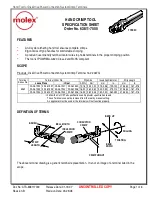
-
102
-
REPLACEMENT OF TIE RODS
A loose tie rod is susceptible to stretching or breakage. The tie rods are designed with
a locking plate to prevent the tie rod nut from turning and loosening.
PROCEDURE:
If a hammer with a failed tie rod is stopped immediately, only the failed tie rod must be
replaced. If the hammer has been operated with a failed tie rod for more than one hour,
all four tie rods should be magna-fluxed in the thread areas to check for stress cracks
caused by the 3 remaining tie rods taking the extra load created when one tie rod
breaks.
The following procedure is for the replacement of a single tie rod.
1. Remove all snap rings and lock plates.
2. Remove the tie rod to be replaced.
3. Discharge the gas pressure. Refer to the “DISCHARGING THE GAS PRESSURE”
section of the manual.
4. Loosen the three remaining tie rod top nuts until they are just hand tight. Do not
loosen the top nuts (R) too far, as oil maybe lost from the gas head.
5. Apply “Anti-Seize” compound on the bottom threads of the new tie rod. Assemble
into the hammer and thread into the bottom nuts.
6. Apply “Anti-Seize” compound to the top thread of the tie rod and on the washer
faces. Place the washer over the top of the tie rod.
7. Hand tighten the top nut (R).
8. Tighten the top nuts. Refer to the “TIE ROD TORQUE CHART” section of the
manual.
9. Install the lock plates. If a lock plate does not drop into place, tighten the top nut (R)
until it does.
10. Install the snap rings.
11. Gas charge the hammer. Refer to the “GAS CHARGING THE HAMMER” section of
the manual.
















































